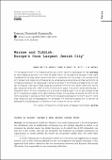Warsaw and Yiddish : Europe’s once largest Jewish city
Abstract
Prior to the Katastrofe (Yiddish for ‘Holocaust’), Warsaw was the world’s capital of Yiddishland, or the Ashkenazic civilization of Yiddish language and culture. In the terms of absolute numbers of Jewish inhabitants, at the turn of the 20th century, New York City surpassed Warsaw. Yet, from the perspective of cultural and political institutions and organizations, Warsaw remained the center of Europe’s Jewish life. This article offers an overview of the rise of Warsaw as such a center, its destruction during World War II, and the center’s partial revival in the aftermath, followed by its extinction, which was sealed with the antisemitic ethnic cleansing of Poland’s last Jewish communities in 1968. Twenty years after the fall of communism, beginning at the turn of the 2010s, a new awareness of the Jewish facet of Warsaw’s and Poland’s culture and history has developed during the past decade. It is a chance for a new opening, for embracing Jewish culture, Yiddish and Judaism as inherent elements of Polish culture and history This country’s history and culture was not created exclusively by Catholics, as ethnonationalists are wont to claim incorrectly. Hence, the essay is intended to serve as a corrective to this anachronistic preconception.
Citation
Kamusella , T 2022 , ' Warsaw and Yiddish : Europe’s once largest Jewish city ' , Wortfolge. Szyk Słów , vol. 6 . https://doi.org/10.31261/WSS.2022.06.10
Publication
Wortfolge. Szyk Słów
Status
Peer reviewed
ISSN
2544-4093Type
Journal article
Collections
Items in the St Andrews Research Repository are protected by copyright, with all rights reserved, unless otherwise indicated.

